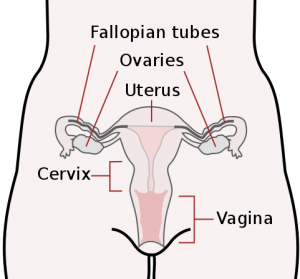Effaced, dilated, ripe: you might have heard these words thrown around by your care providers, friends who have had babies, or even on TV. Here, we will discuss your cervix and what it means for your labor and your baby’s birth when someone uses these words to describe it.
What is your cervix?
Your cervix—located at the lower end of the uterus—is a kind of cylinder that narrows to connect your uterus with your vagina. It is usually three to five centimeters long and made of muscle and connective tissue that can soften and expand a small amount during your period to allow menstrual blood to leave the uterus, during intercourse to let sperm enter the uterus, and a large amount during labor to provide an opening for baby to pass through.
During most of pregnancy, the cervix points toward the pregnant person’s back, but as the time of baby’s birth approaches, it moves forward to point more toward the front of the body. Your doctor or midwife might check to see which direction your cervix is pointing toward the end of your pregnancy. Its position can be described as posterior, which means toward your back, anterior, which means toward your front and easy to feel, or midline, which is somewhere in between and also sometimes called mid position.
Your Cervix and Birth
Your care provider can assess how soft, thin, and open your cervix is, which could give some clues about when baby is coming. For instance, throughout most of pregnancy your cervix is firm. If you were to feel it, it would feel a bit like touching the end of your nose. When your body prepares to birth a baby, the release of hormones and prostaglandins instructs your cervix to soften, which is sometimes also called ripening. If your cervix feels a little mushy, your care provider might describe your cervix as ripe or soft. Your cervix will likely become softer as pregnancy and labor progress.
Your cervix also prepares for baby by effacing or thinning, and as baby’s head drops down, it may speed up this process. As discussed above, the cervix is typically between three and five centimeters long, which your care provider can determine during a vaginal exam. If your cervix is typically four centimeters long, but has shortened or thinned to two centimeters, then your care provider will estimate that your cervix is 50% effaced. If you have less than a centimeter of cervical length, you are probably 80 to 90% dilated. Once your cervix has thinned completely, your midwife or doctor will estimate that you are 100% effaced.
Cervical dilation is another indication that baby is on his or her way, and a key marker of your labor’s progress. During pregnancy, your cervix stays closed tightly to protect baby. Dilation, then, is the opening of the cervix that generally happens after it has both softened and thinned. Your care provider also estimates this degree of opening in centimeters during a vaginal exam. It is possible to be dilated a few centimeters and not yet be in active labor, but you must be approximately 10 centimeters or completely dilated before baby can be born. Sometimes a pregnant person’s cervix dilates slowly and steadily from one to 10 centimeters and other times it may appear to be stuck for a while at six or seven centimeters and then quickly dilate completely.
Induction and Your Cervix
The steps of softening, thinning, and opening described above can happen on their own during birth. Sometimes, though, your body needs a bit of help, in which case your care provider may suggest an induction. Induction can include many different aspects, but the two that pertain specifically to your cervix are ripening and dilation.
If your cervix has not softened much, your care provider may give you a drug that will help ripen the cervix. Usually these drugs are composed of prostaglandins and are applied directly to the cervix in the form of a gel or a simple device that releases the drug gradually over about twelve hours.
To help your cervix dilate, your doctor may insert a balloon called a Foley catheter into the cervical opening. Then, he or she will fill the balloon with liquid and as it expands, it will increase the opening of your cervix. In a clinical trial comparing these two methods, researchers found that starting induction with a Foley catheter was better than beginning with prostaglandins when jumpstarting labor.


